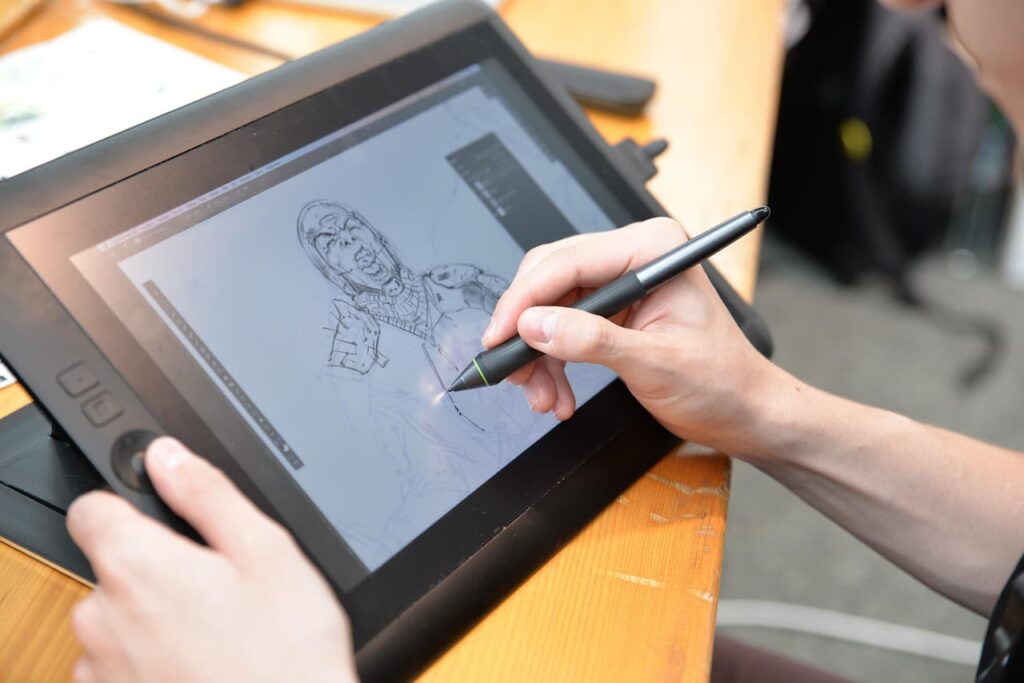Artists love to pretend there’s some grand philosophical debate between traditional and digital art. There isn’t. The real question is simpler and way more practical: which one helps you actually finish your work without wanting to throw your tools out the window?
Because here’s the thing about human nature: we’re terrible at sticking with creative projects when the friction gets too high. Traditional art has physical friction. Digital art has decision friction. Both will mess with your head in different ways, and understanding how is the only way to pick the right one for your situation.
What Traditional Art Actually Feels Like
To start with the basics, traditional art means you’re stuck with your mistakes in a way that digital artists will never understand. You put down a line in ink, and that line is there forever unless you want to start over completely.
In many ways, this permanence becomes both a curse and a teacher. This sounds like a nightmare, but it actually forces you to commit to decisions instead of endlessly tweaking the same detail for three hours.
Moreover, beyond the discipline it builds, the tactile feedback is real. You feel the pencil drag across the paper’s texture. You see how watercolor bleeds differently depending on how wet your brush is. Your hand gets tired from holding tools at certain angles.
All of this creates a physical connection to your work that screens can’t replicate, which is a good sign if you’re the type who needs that sensory input to stay focused.
However, as every traditional artist eventually learns, the experience isn’t all magic and nostalgia. But let’s be honest about the downsides in the following way: For one thing, materials cost money, and they run out. Good paper, quality brushes, and professional-grade paints add up fast if you’re serious about this.
In addition, over time, storage becomes a problem real quick. Where are you putting 50 finished paintings? What about the 200 practice sketches you can’t throw away because one day you might reference them? Even worse, when documenting work, scanning and photographing your work for portfolios is annoying.
What Digital Art Actually Feels Like

By contrast, moving digital changes everything. Digital art removes almost all physical barriers to creation. You need a device and software that lets you have infinite options. At first glance, this freedom seems like a dream come true. This sounds perfect until you realize that infinite options create their own kind of paralysis.
In other words, the problem flips. When you can undo every mistake, you start second-guessing everything. Is that line in exactly the right spot? Should it be two pixels to the left? What about the color? Does it need to be 5% more saturated? Before long, perfectionism quietly replaces progress.
Before you know it, you’ve spent an entire session adjusting things that literally nobody except you will ever notice. Still, to give digital art full credit, here’s what it actually offers: First and foremost, speed and efficiency that traditional art can’t match. You can duplicate elements, resize compositions, and test different color schemes in seconds instead of hours.
Beyond that, professional tools like Photoshop, Procreate, and Clip Studio Paint have features specifically built for illustration work. Perspective guides, symmetry tools, and custom brushes that mimic real media.
Equally important, easy sharing and client revisions. Export a file, send it anywhere instantly. Client wants changes? Adjust and resend. No reprinting, no shipping, no waiting.
Moreover, over the long term, lower costs once you’ve bought the equipment. No restocking of paint or paper. Your brushes never wear out. Storage is just hard drive space.
Picking Based on Your Actual Situation
With both sides laid out, the next step is clarity. So how do you decide which one to focus on? Stop thinking about artistic philosophy and start thinking about practical constraints in your life right now.
For instance, when it comes to living space, if you’ve got limited room, digital makes more sense. You can’t store 100 canvases in a studio apartment, but you can store 1000 digital files on a small drive.
Similarly, in financial terms, if you’ve got a limited budget upfront, traditional is cheaper to start. A sketchbook and pencils cost less than an iPad and Procreate. But long-term, digital saves money on materials.
Likewise, regarding time and productivity, if you need to build a professional portfolio fast, digital is the way. It’s easier to produce finished, polished work quickly when you can undo mistakes and use shortcuts.
On the other hand, in terms of learning habits, if you learn better through physical repetition, traditional methods might stick better. The muscle memory from actually drawing lines by hand transfers differently from screen work.